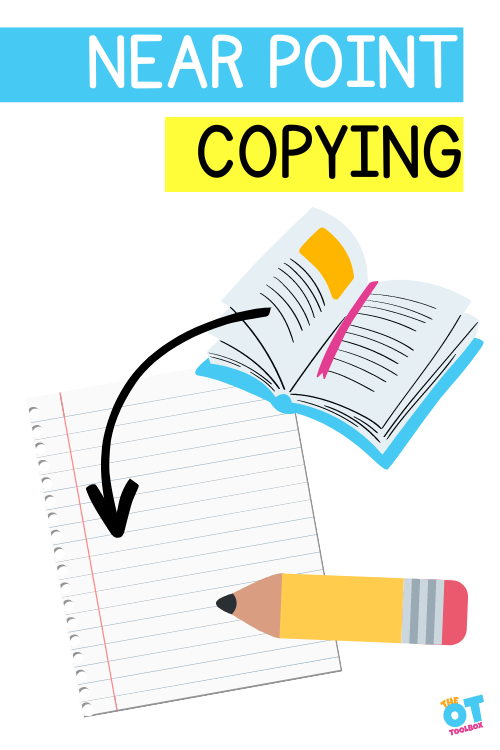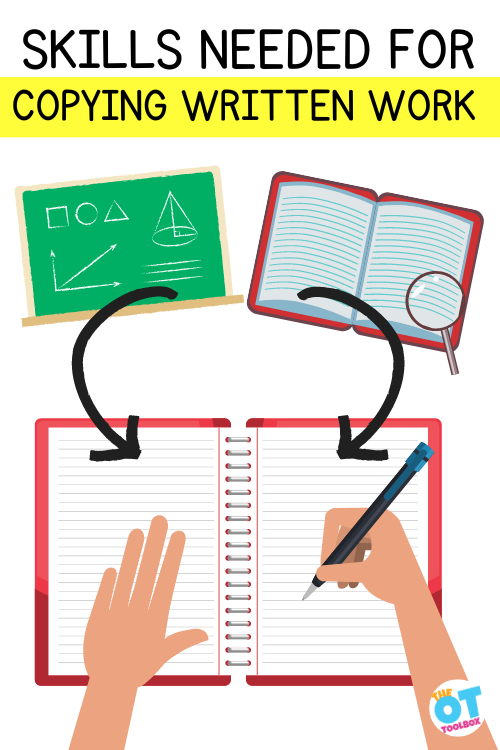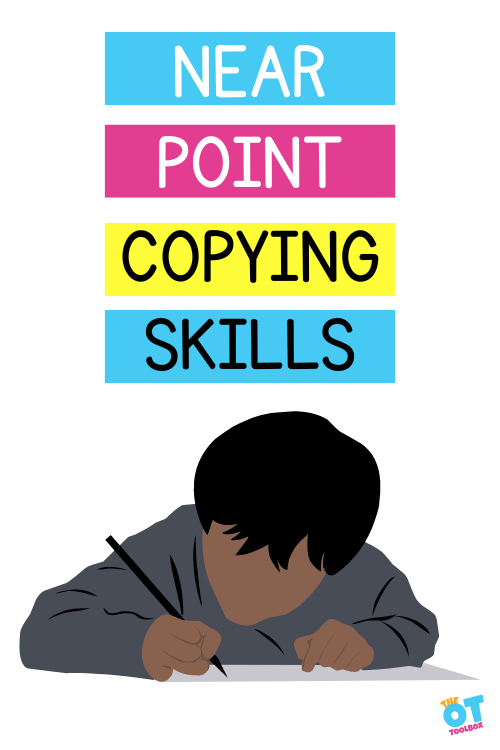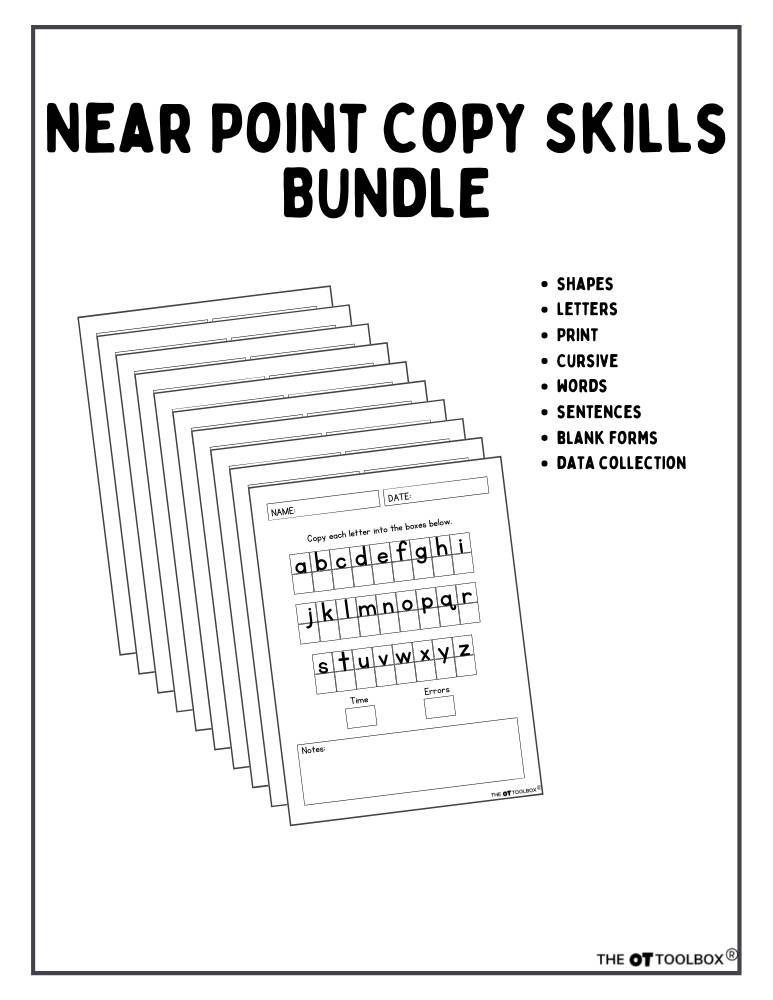In the school setting, near point copying skills is a visual motor skill that enables students to copy written material from a book, workbook, or information source onto a paper. Copying material is a part of every grade. This is an area of functional handwriting that is covered in occupational therapy sessions through play because copying material at various levels is part of the educational process. In this blog post we are covering everything you need to know about near point copy skills.

Near Point Copying
Near point copying refers to the ability to write down and copy written material from a close point such as a desk surface. Close copy is a graded skill on the continuum of copying from a far point. Writing from a source is an essential stepping stone to far point copy.
Near point copying involves imitating or replicating what is seen in close proximity.
Far point copying, on the other hand, might involve copying from the board. Far point copying is more difficult than near point, because of the increase in working memory, visual attention, short term memory, visual saccades, and visual closure are involved.
Handwriting is a complex process and copying skills are just one step of the process.
Whether copying from a given space on a desk surface such as a book or notebook, there can be areas of breakdown that impact handwriting legibility:
- Letter forms (letter formation)
- Letter placement on lines and placing letters on the baseline (line awareness)
- Spacing between letters and words (spatial awareness)
- Letter size (size awareness)
- Letter omissions
This skill starts in kindergarten when young children copy words as in “write the room” activities. The ability to copy from a workbook, book onto a writing page develops with refined motor skills in older grades. In first grade or second grade, the copying skills move to workbook pages and lined paper. This skill becomes more efficient and fluent in middle school and high school, and then to college.
The ability to copy written material onto paper doesn’t stop there.
Copying from one point to another is a functional task used throughout the lifespan when copying words, lists, phone numbers, or other information onto a writing surface.
New skill acquisition has to start somewhere. It often begins with copying or mimicking. Babies smile in response to the smile of others. Children learn to catch by demonstration. Written expression starts by imitation, specifically near point copying.
copying from the board and occupational therapy
One functional area that an occupational therapy practitioner may address is copying from the board. In OT, this might mean working on progressively more challenging visual motor tasks so that the student can copy notes, homework lists, important information, etc. from a far point.
Copying from the board occupational therapy activities might include:
- Assessing where challenges are stemming from (visual perception, visual shift, visual attention, working memory, etc.)
- Targeting specific underlying skills
- Progressive training to copy smaller chunks of information
- Self-checking and self-assessment strategies
- Tools for tackling the copying task
- Practice with various tools and strategies
Copying from the board occupational therapy accommodations might look like:
- Larger font size for copying
- Using a visual tool like a highlighted strip
- Following words with a writing and reading stick
- Boxes drawn around the information on the board to draw attention to the information that needs to be copied
- Different colored dry erase markers or chalk used for copying from the Smartboard or chalk board
- More space between the information
A handwriting rubric can be a useful strategy used in occupational therapy to help identify where the copying skill is breaking down.

Skills needed for near point copying
As always, occupational therapy practitioners refer to the underlying skill components that play a role in functional tasks. In the task of copying handwriting material onto paper, there are specific skills that impact functional performance.
The following skills are necessary for near and far point copying:
- Language skills – If a child has to copy letter by letter because he doesn’t know how to spell well enough, it takes a lot more time for him than for other students.
- Working memory – A student with poor working memory may not be able to hold the information in his head long enough to get it down on paper. Read about working memory skills)
- Pencil grasp – a learner with poor pencil grasp may take longer to write, fatigue easier, be inefficient, or spend extra mental energy trying to hold the writing tool
- Coordination – coordination is necessary to write, hold the paper, sit in a chair, and shift the head and eyes to focus at different distances. Read about eye-hand coordination.
- Muscle weakness – often leads to writing fatigue, inefficient grasping pattern, poor sitting tolerance, and difficulty with letter formation. Read about hand strengthening.
- Vision – difficulty scanning and shifting focus from the board to paper, or top to bottom of the paper, convergence and divergence of the eyes as they focus on relevant information. Rule out possible visual acuity issues first like convergence insufficiency
- Visual perception – a student who can not “see” what is written in front of them will have difficulty copying it correctly. Rule out visual perceptual difficulties by doing a motor free visual perception screener before addressing writing difficulties. Read about visual perceptual skills.
- Visual motor skills- copying letter forms and letters require eye movements and the visual motor integration to copy letters and words. It’s a step up from copying shapes that we often use as a tool in occupational therapy sessions. Read about visual motor skills.
A word about near point copying
Near point copying is a stepping stone to independent writing. Copying is an excellent way to learn to draw and write, while focusing directly on visual and fine motor skills. It is important to understand and be confident at the basics before adding higher level cognitive skills such as spelling, remembering the formation of letters, and sentence generation. This is the same thought process that learners understand numbers and addition/subtraction, before heading on to fractions and multiplication.
In order for copying to be meaningful and lead to success, the learner needs to understand what they are copying. A learner who does not know their letters, will essentially be copying balls and sticks, rather than understanding the written word. This is why copying is a stepping stone that should eventually move forward to writing from dictation, memory, or original thoughts.
Near Point Copying Red Flags
Some of the areas you may see a when near point copying skills are a challenge:
- Maladaptive behavior during handwriting. Frustration, fatigue, distraction
- An awkward pencil grasp
- Messy writing compared to their peers
- Challenges with directionality
- No awareness of the lines on the paper or borders during writing or coloring
- Poor knowledge of the letters/shapes/numbers
- They rush through their writing
- They can not form the upper or lowercase letters
- Reversals of letters and numbers frequently (this is common for young learners and not always a sign of dysfunction)
- Do they avoid writing altogether?
- Poor fine motor skills such as cutting, drawing, tying shoelaces, or stringing beads
Not all learners with poor or delayed handwriting have a learning disability or other disorder. Sometimes they need extra help because they never received appropriate teaching of letters and numbers. Other times they just fell behind, did not get enough high quality practice, or lack confidence in their skills.

How to develop Near Point Copying Skills
These intervention strategies can support near point copying skills:
- If your learner is not ready to copy into these grids, try working on copying using a dry erase board, magnadoodle, their finger in the air, a table full of shaving cream, or a cookie sheet with salt
- Vary the writing utensils to add to success.
- Trialing various forms of adaptive paper can support visual scanning needs, particularly when transferring written information from a source onto paper. As the vision shifts from the material to be copied back to the paper, the eyes can “jump” around to find the place where material is to be written. Various forms of visual prompts such as highlighted lines, margin lines, etc. can bring awareness to the writing lines and support this need.
- Use puzzles to complete a picture. Place puzzle pieces on a desk surface and place the box lid with a picture of the completed puzzle on the table surface. The student can then complete the puzzle using the picture as a visual guide.
- Mazes are a tool for addressing pencil control while visually scanning on the page. This is a way to work on the visual motor integration needed for copying words or letters from a near point.
- Use visuals to complete sequencing activities. Cut out pictures or use word labels and ask the student to put the words or visuals in order to match a picture or create a sequence for an end result.
- Work on visual perceptual skills identifying same/different, hidden pictures, visual memory, and scanning
- Memory board games- This is a great way to work on visual memory, visual attention, working memory, and other skills
- Use a crayon or marker to copy coloring forms. One way to do this is using color by number activities.
- Use a paper placed on the desk surface with letters of the alphabet. The student can point to letters with their index finger and name the letters. A letter-naming activity like this is a progression toward visual memory and recall to support writing the letter form.
- Consider using a slant board to elevate the writing surface or the writing stimuli. A slant board can also be used for copying from a far point.
- Check writing posture. When slouching or laying across a table surface, the visual motor skills are not able to copy accurately, relating to inconsistent use of letter size, line use, and copying without omissions or adding extra letters.
- Teach letters and shapes through use of books, flashcards, manipulatives, games, or other tools
- Have your learner practice remembering more than one letter at a time when copying from the board. They can start this by learning to retain information in near point copying as they do not have to retain the information as long.
- Practice vision skills such as saccades needed for copying
- Here is a great post on copying skills
Start by going back to the basics, re-teaching these skills, and putting in the practice to develop basic handwriting skills before moving on to higher level work. A learner who simply needs to have practice and confidence will learn very quickly. Someone who has a learning disorder or other diagnosis will take much longer to acquire these skills. Whatever the reason for the delay; practice, using effective tools such as the near point copying bundle, making writing fun, and using varied resources will help.
near point copying worksheets
Near point copying worksheets can be as simple as copying letters from the top of the page to the bottom of the page. It can also look like copying a sentence from a prompt at the top of the page.
There are graded progressions, too. These can be more functional and things that we do in everyday tasks:
- Copying a list of information from one source to another side by side
- Copying words to fill in blanks from a book to a worksheet
- Copying dates and times onto a paper planner or calendar
- Copying long form numbers from a computer screen to an accounting worksheet (checkbook or other tracker)
- Copying from a near vertical position, requiring vertical shift as well as lateral shift
These skills can look like a wide variety of examples. Using near point copying worksheets is a nice way to work on this progression as well as practicing the functional task that the individual needs to improve upon.
With a near point copying worksheet, you can collect data and include modifications or grade the activity.
NEAR POINT COPYING Printable Packet
The OT Toolbox has a great tool for learning and practicing near point copying. The Near Point Copy Skills Pack addresses visual memory skills, visual attention, and visual motor integration skills so learners can copy material without missing information.
This essential handwriting skill can be a challenge for many, and leads to difficulties with copying written material from a distance, or with visual shift. It is full of printable worksheets for copying letters, shapes, words, cursive, and sentences. It also includes black worksheets and a data collection page. This Near Point Copying bundle is a great resource to add to your library. It is available HERE in the shop, or free as a level 2 member!
How to use the near point copying worksheets in the printable pack:
- Start with the largest boxes first. New learners do not have the intrinsic musculature to draw in small spaces
- Basic shapes and lines are important pre-writing skills
- Change the sort order of copying tasks to limit memorization
- Start at different points each time if your learner can not do all of the page in one sitting. This way they do not always fatigue at letter j, never finishing to z
- Laminate for use with wipe off markers. Reusable tasks are more eco-friendly
- Project onto a smart board to include written examples, far point copying, and working in a different perspective
And the next step is copying from a chalkboard for far point copying!

Victoria Wood, OTR/L is a contributor to The OT Toolbox and has been providing Occupational Therapy treatment in pediatrics for more than 25 years. She has practiced in hospital settings (inpatient, outpatient, NICU, PICU), school systems, and outpatient clinics in several states. She has treated hundreds of children with various sensory processing dysfunction in the areas of behavior, gross/fine motor skills, social skills and self-care. Ms. Wood has also been a featured speaker at seminars, webinars, and school staff development training. She is the author of Seeing your Home and Community with Sensory Eyes.
This packet of near point copy exercises includes data collection areas on each page, allowing users to identify needs in copying speed of written work and letter copying issues, as well as handwriting and letter formation needs.
This packet includes copying materials for:
- Pre-Writing Shapes
- Printed Letters
- Cursive Letters
- Upper case and lower case letters
- Words
- Sentences
- Cursive Words
- Cursive Sentences
- Various grades of writing paper sizes
- Data Collection Sheets
Use this printable packet to work on copying skills and visual processing integration from grades Kindergarten-through High School (and beyond).







